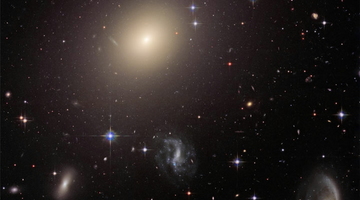Dr Melanie Johnston-Hollitt, from Victoria University of Wellington, explains how a new generation of radio telescope (called the Square Kilometre Array) will help explore the far reaches of the universe.
Transcript
DR MELANIE JOHNSTON-HOLLITT
For now the radio telescope that I use is in Australia, which is called the Australia Telescope Compact Array, does a very, very good job of satisfying my needs for research. But I have also in the past used telescopes in the US. I have used the VLA which is the very large array in New Mexico. I have also used a radio telescope in India called the GMRT which is the giant metrewave telescope, radio telescope. That’s in a place called Pune, or near a place called Pune. So, yeah for now, they are very good.
But… but in the future we are building bigger and better radio telescopes to do more exciting science and I am very excited about that. For me, in particular, they will allow us to detect clusters going back much further in time than we currently can access. The idea that has come about is the idea of the square kilometre array, which is an array of radio dishes which has the collecting area of one square kilometre. A consortium of 17 countries has been working for many years now to try and get this together. It will be a billion dollar project or 2 billion dollar project, depending on what currency you are talking about. They are looking at building it in either Southern Africa or Australasia and one of the things that we want to do there is have lots and lots of collecting area, but also the collecting area has to be widely spaced, so up to 5 thousand kilometres between the centre and the edges. This gives us very high resolution, so it allows us to see much more detail on the radio than we have ever seen before. There was an international study commissioned a few years ago to look at the types of places that you might want to put this next generation radio telescope and then there were a number of parameters that came out that you would want. So, you want something which is radio quiet which means you don’t want a lot of noise in the radio spectrum like mobile phones, microwaves, even some answering machines. You want a place which is not very heavily populated. For scientific reasons we want access to look at the centre of our galaxy, the Milky Way, and the Southern Hemisphere has an excellent view of the centre of the Milky Way including the supposed black hole, Sagittarius a star and things like that. And you want a place where it is nice and politically stable, where it is roughly flat, so forth. So, if you look at all these things then you find that Australasia and Southern Africa fit the profile the best and so these places are currently under consideration for the building of the telescope.
Acknowledgements:
Sarah Brough
Antennas of the Australian Telescope Compact Array, J.Masterton, © CSIRO
NASA/NRAO/NSF
SKA, Xilostudios, www.skatelescope.org/outreachandeducation
Shingo TAKEI, www.takeishingo.com





